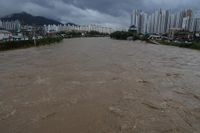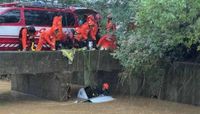For residents of South Korea’s capital region, the past two days have been a harrowing reminder of the power of nature. Torrential downpours began early Wednesday, August 13, 2025, sweeping across Seoul and its neighboring cities—Paju, Incheon, Gimpo, and beyond—leaving a trail of destruction, heartbreak, and uncertainty in their wake. By Thursday afternoon, the rain had finally begun to ease, but not before claiming lives, flooding neighborhoods, and forcing a massive emergency response.
According to the Associated Press, the relentless rainfall dumped between 270 and 320 millimeters (10.6 to 12.5 inches) across parts of the greater Seoul area, with some local weather stations recording even more staggering hourly rates. On Deokjeok Island, for example, 149.2 millimeters fell in just one hour on Wednesday morning—a deluge that overwhelmed drainage systems and turned city streets into fast-moving rivers of mud and debris.
Tragically, the storm proved fatal for several individuals. The Korea JoongAng Daily reported that three people lost their lives in separate incidents across Incheon, Gimpo, and Pocheon. In one case, a car skidded on a slick road in Incheon’s Jung District and plunged into a lake, killing the driver. In Gimpo, a vehicle was swept away by a swollen stream, and a man was found dead in the back seat. Another fatality occurred in Pocheon when an SUV lost control and struck a traffic light, resulting in the death of a passenger. The loss of life has cast a somber shadow over the region, with authorities urging residents to remain vigilant in the face of such unpredictable weather.
The scale of the flooding has been extraordinary. By Thursday morning, more than 1,000 people had been forced to evacuate their homes, according to reports from multiple outlets, including Korea JoongAng Daily and the Associated Press. Emergency shelters—schools, senior centers, and public facilities—quickly filled with families unable to return to their flooded residences. The Ministry of the Interior and Safety confirmed that, as of 11 a.m. Thursday, at least 759 evacuees had not yet been able to go home. In total, 733 people from 500 households were evacuated across Seoul, Incheon, and Gyeonggi Province, with many still waiting for the all-clear to return.
Scenes of devastation unfolded across the capital region. In Uijeongbu, vehicles were left stranded on submerged roads, while residents in low-lying homes scrambled to salvage whatever belongings they could from the advancing waters. Central markets in Incheon’s Seo District were inundated, forcing evacuations from underground spaces. In Songhyeon-dong, Dong District, the collapse of a retaining wall in an apartment complex prompted urgent safety measures. Firefighters and rescue workers, responding to hundreds of emergency calls, worked tirelessly to save those trapped by the floods—from people stuck in greenhouses and houses to drivers caught in submerged vehicles.
Infrastructure took a beating as well. As of early Thursday, 358 facilities—including public buildings and private businesses—reported damages, along with 208 roads and 145 buildings that were flooded, according to local government data cited by Korea JoongAng Daily. In Uijeongbu alone, authorities documented 31 cases of flooded homes, 13 inundated businesses, 34 waterlogged roads, and one incident of soil erosion. Goyang received about 150 reports of damage, including 120 flooded roads and 26 homes.
Power outages added to the chaos. The Ministry of the Interior and Safety said that some 4,000 households lost electricity overnight, though crews managed to restore power by Thursday morning. Amid all this, there was at least one bit of good news: despite the severe weather, no flights were disrupted at Seoul’s airports, allowing for the continued movement of people and goods in and out of the region.
The authorities’ response has been swift and, by all accounts, massive. The Korea Forest Service, alarmed by the potential for landslides on already saturated hillsides, raised its landslide risk alert for Seoul, Incheon, Gyeonggi, and Gangwon from "caution" to "serious"—the highest level—on Thursday. Landslide warnings and evacuation orders were issued for areas near rivers and streams, and dozens of riverside parks and more than 100 hiking trails were closed to the public as a precaution. Gyeonggi Province raised its disaster response level from Level 2 to Level 3, the highest alert, for only the second time this year.
Emergency workers rescued at least 145 people, responding to hundreds of reports of blocked roads, stranded cars, and trapped residents. In one dramatic incident, firefighters used ropes to evacuate 36 people stranded by rising valley waters in Yangju. Elsewhere, six individuals were pulled from a flooded greenhouse in Goyang, while four people managed to escape from submerged vehicles in Mansong-dong, Yangju. Such stories of survival have offered glimmers of hope amid the destruction.
As the rain tapered off Thursday afternoon, weather officials warned that the danger had not entirely passed. The Korea Meteorological Administration cautioned, “Rain has let up somewhat, but heavy showers are expected to return by early Thursday morning. We urge the public to be extremely cautious to prevent further damage from floods or landslides.” The specter of more rain loomed large, keeping emergency services and residents on edge.
Underlying the immediate crisis is a growing concern about the role of climate change in intensifying such extreme weather events. As reported by multiple outlets, experts have noted that the Korean Peninsula is experiencing more frequent and severe rainfall, increasing the risk of flash floods and landslides—especially in densely populated urban areas like Seoul. The pattern is all too familiar: warmer air holds more moisture, leading to heavier downpours when storms do strike. The result? Urban infrastructure, often designed for less volatile conditions, struggles to cope, and ordinary citizens bear the brunt.
Even as the floodwaters begin to recede, the task of recovery is only just beginning. Officials will need to assess the full extent of the damage—both to property and to the region’s sense of security. For the families who lost loved ones, the scars will linger far longer than the puddles on the streets. And for policymakers, the events of this week serve as a stark reminder: adapting to a changing climate is no longer a distant challenge, but an urgent, present-day necessity.
As Seoul and its neighbors dry out and take stock, the resilience of the community is on full display—neighbors helping neighbors, first responders risking their safety, and local governments scrambling to restore normalcy. But the memory of these two days of rain will not soon be forgotten.


